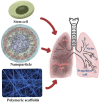The Potential Contribution of Biopolymeric Particles in Lung Tissue Regeneration of COVID-19 Patients
- PMID: 34833310
- PMCID: PMC8623030
- DOI: 10.3390/polym13224011
The Potential Contribution of Biopolymeric Particles in Lung Tissue Regeneration of COVID-19 Patients
Abstract
The lung is a vital organ that houses the alveoli, which is where gas exchange takes place. The COVID-19 illness attacks lung cells directly, creating significant inflammation and resulting in their inability to function. To return to the nature of their job, it may be essential to rejuvenate the afflicted lung cells. This is difficult because lung cells need a long time to rebuild and resume their function. Biopolymeric particles are the most effective means to transfer developing treatments to airway epithelial cells and then regenerate infected lung cells, which is one of the most significant symptoms connected with COVID-19. Delivering biocompatible and degradable natural biological materials, chemotherapeutic drugs, vaccines, proteins, antibodies, nucleic acids, and diagnostic agents are all examples of these molecules' usage. Furthermore, they are created by using several structural components, which allows them to effectively connect with these cells. We highlight their most recent uses in lung tissue regeneration in this review. These particles are classified into three groups: biopolymeric nanoparticles, biopolymeric stem cell materials, and biopolymeric scaffolds. The techniques and processes for regenerating lung tissue will be thoroughly explored.
Keywords: COVID-19; biopolymeric nanoparticles; biopolymeric scaffolds; lung; stem cells; tissue regeneration.
Conflict of interest statement
The authors declare no conflict of interest regarding the publication of this paper.
Figures






References
-
- Elashiry M., Elsayed R., Elashiry M.M., Rashid M.H., Ara R., Arbab A.S., Elawady A.R., Hamrick M., Liu Y., Zhi W., et al. Proteomic Characterization, Biodistribution, and Functional Studies of Immune-Therapeutic Exosomes: Implications for Inflammatory Lung Diseases. Front. Immunol. 2021;12:636222. doi: 10.3389/fimmu.2021.636222. - DOI - PMC - PubMed
-
- Jin H., Zhao Z., Lan Q., Zhou H., Mai Z., Wang Y., Ding X., Zhang W., Pi J., Evans C.E., et al. Nasal Delivery of Hesperidin/Chitosan Nanoparticles Suppresses Cytokine Storm Syndrome in a Mouse Model of Acute Lung Injury. Front. Pharmacol. 2021;11:592238. doi: 10.3389/fphar.2020.592238. - DOI - PMC - PubMed
Publication types
Grants and funding
LinkOut - more resources
Full Text Sources

